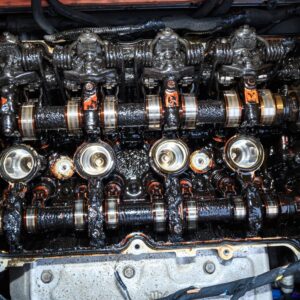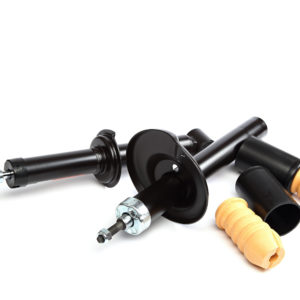Reducing friction is key to prolonging the lifespan of most car parts一especially those that are constantly put under extreme stress and exposed to high temperatures.
Suspension parts fall under the category of components that are subject to wear, and keeping them lubricated is arguably the best way to extend their service life.
The Need for Grease
Like most metal parts in the chassis, suspension components are often exposed to contaminants, corrosion, and the elements. These can affect the movement of ball joints, bushings, and other components over time and result in drivability issues.
The goal of the suspension grease is to lubricate the suspension parts well enough to ensure proper ball stud movement and keep contaminants away from these parts for as long as possible.
Original equipment (OE) suspension parts are usually non-serviceable. This means that they’re pre-lubricated, but that’s the only layer of protection they have.
The grease that came with these parts can get dirty and break down over time because of heat and contamination, which is why you’ll need to apply fresh grease after a while.
Applying fresh suspension grease ensures that all critical areas are lubricated properly and that contaminated grease is removed from the joints and the ball and bearing assembly.
It also fills in the cavities of the dust boot, creating a seal that prevents water from entering nooks and crannies that can develop rust.

Other Advantages of Greasing Up Your Suspension
About 50% of premature bearing failures are related to poor lubrication, and only 1% to 3% of a typical maintenance budget is spent on lubricants.
What does this mean?
This means that failure to keep your suspension lubricated can result in expensive repair costs. Lubricating your suspension is essentially an investment because it reduces maintenance requirements.
A well-lubricated suspension can mean fewer repairs for your vehicle, which translates to more savings.
Friction is the enemy of most machinery, including vehicles. A poorly lubricated suspension can take up more torque, which essentially increases energy consumption. Greasing your suspension can create smoother movements for your vehicle and lessen the need for power.
What to Expect from Ungreased Suspensions
Poor lubrication is often the root cause of mechanical issues. If your suspension isn’t lubricated properly, you can expect to hear squeaking noises as you go over bumps and groaning noises when you turn.
Overall, you’ll feel that your vehicle’s ride quality isn’t as smooth as before.
Rubber bushings and ball joints are some suspension parts that are most likely to wear out fast because of poor lubrication.
Worn-Out Rubber Bushings
Defective or worn-out mounting bushings can create loud squeaking or knocking sounds.
Meanwhile, worn-out strut rod bushings can cause the lower control arm to sway back and forth when braking or hitting bumps in the road.
Worn-Out Ball Joints
Ball joints let the wheels move up and down and side to side. Worn-out ball joints can greatly affect a vehicle’s handling and cause looseness in the suspension. If left unaddressed, the following problems can occur:
- Loud popping and squeaking noises when driving over curbs
- Shimmy-type vibration can be felt in the steering wheel
- Vehicle can wander or have trouble moving in a straight line
- Excessive free play in the steering wheel
Choosing the Best Suspension Grease for Your Vehicle
The best type of suspension grease will always depend on your vehicle manufacturer’s recommendations.
As with engine oil, there are several types of suspension grease available in the market. Here are the most common ones.
Silicone Grease
Silicone grease is suitable for lubricating rubber components like bushings. This type has excellent lubricating properties, reducing friction and wear between components and providing protection against water and corrosive substances.
Lithium-Based Grease
Lithium-based grease is designed to withstand extreme temperatures and loads, making it ideal for heavy-duty vehicles.
Synthetic Oil
Synthetic oil is the most expensive type of suspension grease available. It’s usually made from polyalphaolefin (PAO) or ester-based oils. Similar to lithium-based grease, this type is also designed for high-performance vehicles.
How to Grease Your Car’s Suspension
Greasing your car’s suspension can be a DIY-friendly task for those who have basic automotive knowledge and some experience in dealing with maintenance tasks.
If you’re someone who’s not confident in your DIY skills yet, you can always bring your vehicle to a trusted auto shop and let a trained professional do the job for you.
But if you think you can handle the task on your own, here’s a quick guide on greasing your suspension.
First, you’ll need the following materials:
- Floor jack
- Grease gun
- Jack stands
- Wheel blocks
- Rags
- Creeper
- Owner’s manual
Note: Consult your owner’s manual to verify your vehicle’s weight before using the floor jack and jack stands. Also refer to the manual to verify whether or not your rear suspension has serviceable parts.
Step 1: Use the floor jack to lift your vehicle and make sure that the jack stands are placed on the chassis. Then, secure the wheels with wheel blocks.
Step 2: Use a creeper (or a piece of cardboard) to slide in and out of the bottom of your vehicle. Keep the grease gun and rag close to you for easier access.
Step 3: Make sure to clean the lubrication fittings and grease gun nozzle with a clean rag before using them.
Step 4: Once you’re under your vehicle, use the grease gun to apply lubricant to the ball joints, tie rods, and other serviceable parts. These components usually have grease fittings on them. Seals or rubber boots should rise slightly when there’s enough grease.
Avoid overfilling a lubricated joint with grease to prevent the rubber seal or bellows from rupturing.
Step 5: Work your way from the driver’s side towards the middle of the vehicle until you reach the pitman arm. From there, you might need to grease the center link and idler arm as well.
Step 6: If your vehicle has an independent rear suspension, you’ll need to lubricate its components, too. Also make sure to check your drivelines because they come with grease fittings.
Where to Get Suspension Parts for Your Ride
Faulty suspension components can ruin your ride. If you’re looking for replacement parts for your suspension system, we’ve got you covered here at CarParts.com. We’re your one-stop shop for new shocks, struts, control arms, or any other suspension component.
Our catalog includes a comprehensive selection of suspension parts for a wide range of vehicle makes and models. Simply input your vehicle’s details into our search tool to find the parts that are compatible with your ride.
All products on our catalog are manufactured to meet or exceed industry standards, ensuring reliable performance and durability. Plus, we have distribution centers located across the country to ensure fast and efficient shipping.
Don’t let worn suspension parts compromise your vehicle’s performance and safety. Explore our selection of suspension parts today and restore your ride’s handling and comfort!
Any information provided on this Website is for informational purposes only and is not intended to replace consultation with a professional mechanic. The accuracy and timeliness of the information may change from the time of publication.






























